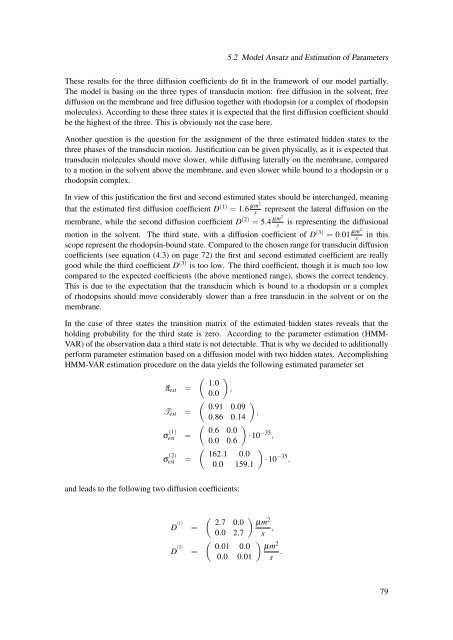Diffusion Processes with Hidden States from ... - FU Berlin, FB MI
Diffusion Processes with Hidden States from ... - FU Berlin, FB MI
Diffusion Processes with Hidden States from ... - FU Berlin, FB MI
You also want an ePaper? Increase the reach of your titles
YUMPU automatically turns print PDFs into web optimized ePapers that Google loves.
5.2 Model Ansatz and Estimation of ParametersThese results for the three diffusion coefficients do fit in the framework of our model partially.The model is basing on the three types of transducin motion: free diffusion in the solvent, freediffusion on the membrane and free diffusion together <strong>with</strong> rhodopsin (or a complex of rhodopsinmolecules). According to these three states it is expected that the first diffusion coefficient shouldbe the highest of the three. This is obviously not the case here.Another question is the question for the assignment of the three estimated hidden states to thethree phases of the transducin motion. Justification can be given physically, as it is expected thattransducin molecules should move slower, while diffusing laterally on the membrane, comparedto a motion in the solvent above the membrane, and even slower while bound to a rhodopsin or arhodopsin complex.In view of this justification the first and second estimated states should be interchanged, meaningthat the estimated first diffusion coefficient D (1) = 1.6 µm2srepresent the lateral diffusion on themembrane, while the second diffusion coefficient D (2) = 5.4 µm2sis representing the diffusionalmotion in the solvent. The third state, <strong>with</strong> a diffusion coefficient of D (3) = 0.01 µm2sin thisscope represent the rhodopsin-bound state. Compared to the chosen range for transducin diffusioncoefficients (see equation (4.3) on page 72) the first and second estimated coefficient are reallygood while the third coefficient D (3) is too low. The third coefficient, though it is much too lowcompared to the expected coefficients (the above mentioned range), shows the correct tendency.This is due to the expectation that the transducin which is bound to a rhodopsin or a complexof rhodopsins should move considerably slower than a free transducin in the solvent or on themembrane.In the case of three states the transition matrix of the estimated hidden states reveals that theholding probability for the third state is zero. According to the parameter estimation (HMM-VAR) of the observation data a third state is not detectable. That is why we decided to additionallyperform parameter estimation based on a diffusion model <strong>with</strong> two hidden states. AccomplishingHMM-VAR estimation procedure on the data yields the following estimated parameter set( ) 1.0⃗π est = ,0.0( )0.91 0.09T est =,σ (1)est =σ (2)est =0.86 0.14( 0.6 0.00.0 0.6( 162.1 0.00.0 159.1)· 10 −35 ,)· 10 −35 ,and leads to the following two diffusion coefficients:D (1) =D (2) =( ) 2.7 0.0 µm2,0.0 2.7 s( ) 0.01 0.0 µm2.0.0 0.01 s79









